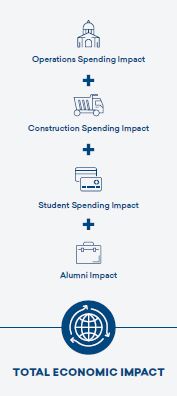
Economic Impact


Economic Impact Analysis
In FY 2018-19, Gateway added $89.8 million in income to the Northern Kentucky* economy, a value approximately equal to 0.4% of the region’s total gross regional product (GRP). Expressed in terms of jobs, GCTC’s impact supported 1,451 jobs.
Operations Spending Impact
- Gateway employed 452 full-time and part-time faculty and staff. Payroll amounted to $13.6 million, much of which was spent in the region for groceries, mortgage and rent payments, dining out, and other household expenses. The college spent another $8.6 million on day-to-day expenses related to facilities, supplies, and professional services.
- The net impact of the college’s operations spending added $16.6 million in income to the regional economy in FY 2018-19.
Construction Spending Impact
- Gateway invests in construction each year to maintain its facilities, create additional capacities, and meet its growing educational demands, generating a short-term infusion of spending and jobs in the regional economy.
- The net impact of Gateway’s construction spending in FY 2018-19 was $133.9 thousand in added income for Northern Kentucky.
Student Spending Impact
- Some in-region students, referred to as retained students, would have left Northern Kentucky for other educational opportunities if not for Gateway. These retained students spent money on groceries, mortgage and rent payments, and other living expenses at regional businesses.
- The expenditures of retained students in FY 2018-19 added $3.1 million in income to the Northern Kentucky economy.
Alumni Impact
- Over the years, students have studied at Gateway and entered or re-entered the workforce with newly-acquired knowledge and skills. Today, thousands of these former students are employed in Northern Kentucky.
- The net impact of Gateway’s former students currently employed in the regional workforce amounted to $69.9 million in added income in FY 2018-19.
Total Impact
The total economic impact of Gateway on Northern Kentucky can be generalized into two broad types of impacts. First, on an annual basis, Gateway generates a flow of spending that has a significant impact on the regional economy. The impacts of this spending are captured by the operations, construction, and student spending impacts. While not insignificant, these impacts do not capture the true purpose of Gateway. The basic mission of Gateway is to foster human capital. Every year, a new cohort of former Gateway students adds to the stock of human capital in the region, and a portion of alumni continues to add to the regional economy. The table below displays the grand total impacts of Gateway on the Northern Kentucky economy in FY 2018-19. The total added value of Gateway is $89.8 million, equivalent to 0.4% of the GRP of Northern Kentucky. By comparison, this contribution that the college provides on its own is nearly as large as the entire Arts, Entertainment, & Recreation industry in the region. Gateway’s total impact supported 1,451 jobs in FY 2018-19.
| Type of Spending | Labor Income (thousands) | Non-labor Income (thousands) | Total Income (thousands) | Sales (thousands) | Jobs Supported |
|---|---|---|---|---|---|
| Operations Spending | $15,376 | $1,268 | $16,644 | $27,758 | 483 |
| Construction Spending | $121 | $13 | $134 | $601 | 2 |
| Student Spending | $2,040 | $1,018 | $3,058 | $11,202 | 76 |
| Alumni | $52,391 | $17,532 | $69,923 | $145,718 | 890 |
| Total Impact | $69,928 | $19,831 | $89,759 | $185,278 | 1,451 |
| % of the Northern Kentucky Economy | .5% | .3% | .4% | .4% | .6% |
